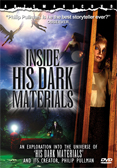Artsmagic finally release in the UK their much delayed Inside His Dark Materials DVD tomorrow, 31st July. The DVD, billed as “a celebratory tribute to Pullman and his books” is an audio-visual documentary about His Dark Materials: its plot, influences and themes. The DVD is roughly broken down into twenty chapters. Each lasts around six minutes, with the documentary clocking in at 120 minutes long. You can read a full review here for now ahead of its release. 
There are interviews with Nicholas Tucker, author of Darkness Visible; the Bishop of Oxford, Dr Woof; an English student at Pullman's old college at Oxford, Exeter, and of course an interview with the man himself. Pullman's interview is spread across the course of the 120 minutes. It is not strictly speaking an interview; there are no questions asked on camera and it's more a monologue on certain themes. Ultimately Pullman says very little that he has not aired elsewhere.
The chapter on Adam and Eve is perhaps most interesting. Pullman explains how Adam and Eve is the central story of the human existence – it encompasses becoming an adult, our blossoming into autonomy, the first moment of rebellion. Pullman remarks that it is beautifully told and he reasserts his belief in the power of a story to change the world. His Dark Materials then is explained as Pullman's attempt to counter the Adam and Eve myth with a world-story of his own – one without God.
The bishop makes some interesting contributions. At the beginning of the documentary he sets the question: what is Pullman? questioning his spiritualality and whether he is atheistic or agnostic. The bishop acts as the restrainer on the adulation of Pullman and raises common criticisms of the trilogy: for example, that the religious / Church characters in the books are somewhat cardboard cutouts, lacking any subtlety or depth in their portrayal as blanket 'evil'.
The main interest of most readers seeking to delve further into His Dark Materials are Philip Pullman's inspirations – notably, William Blake and John Milton, the latter of which is referenced often by the speakers on the disc. Pullman's angels are linked to Blake's, who envisioned angels not as Biblical, but as an expression of ultimate truth and beauty. Heinrich von Kleist and the Marionette Theatre are spoken of also, whilst for the 20th Century Pullman gives his influences as mostly filmic – Hitchcock in particular.
The documentary makes constant use of computer-generated images to illustrate its points. These images are somewhat of a mixed-bag. Many simply do not work – the CG Lyra is a terrifying wooden puppet sort-of-a character, whilst Lord Boreal and Lee Scoresby both bizarrely sport large sombreros. Highlights however include the glittering bridge to the stars and the numerous schematics of items from the books – the alethiometer, the amber spyglass and the clattering cog-wheels nestling inside Mrs Coulter's clockwork beetle spy. Those scenes involving movement generally manage to be more engaging. There's a clever Lyra-point-of-view shot from astride Iorek, viewing his bear head nodding as he lollops across the snow; a shot re-used later behind an angel approaching Lord Asriel's fortress, which is cast atop a lake of lava. Views of landscapes in “our world” are generally out of place – though there are the requisite shots of Exeter College and some interesting visuals of a ruined town for Cittagazze. There appear to be three different Lyra models used during the course of the documentary, with the older Will and Lyra looking rather glum.
The issue is, are these images necessary? The documentary would perhaps be better suited as a radio production. The images are somewhat superfluous and the impression is felt that it is a DVD because it can be, not because it needs to be.
The documentary as a whole seems confused as to whom it is targetting. At first it leaps into religion and Pullman's philosophy straight-away, yet segues from this impenetrable (to outsiders) start eventually into plain plot summaries.
The numbers reveal this major flaw of the production: over half of all the chapters are used to simply narrate the trilogy's story. For anyone who has read the books, these chapters can be mind-numbingly dull as they simply recount the story slowly to some ill-formed CG images. The DVD is overlong for those looking for an introduction to the books, which can be found far more concisely than in a two hour sit-down. However, those seeking an indepth examination of the books will be left wanting and quite possibly bored. There really is too little content spread out over too lengthy a time. It is a documentary certainly viewed best in chunks – not the full two-hours at once for a review!


Even if it sounds kind of bad, I want to watch it anyways. I love documentaries, they always manage to entertain me, even when people find them dull.
it was not bad at all, just use your imagination if the images don't suit you. think like a child, i'm lucky, i'm 20 and i still haven't forgotten how.
Pingback: Documentario su Queste Oscure Materie online « Queste Oscure Materie.net